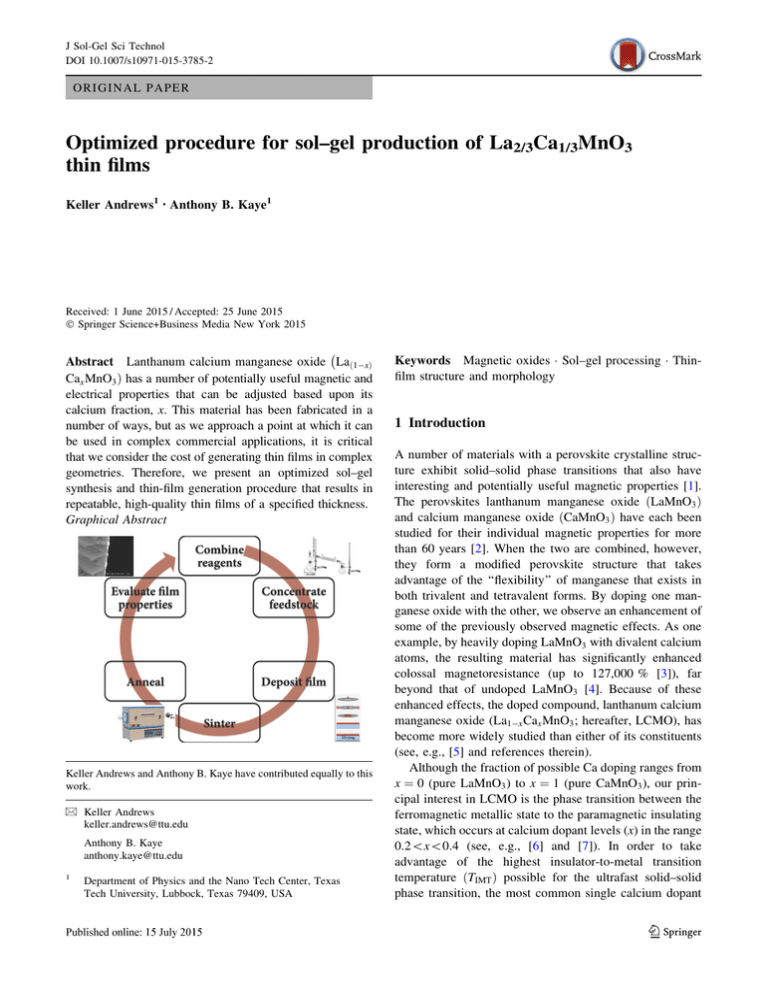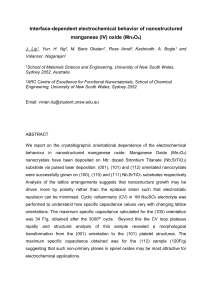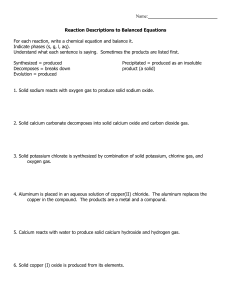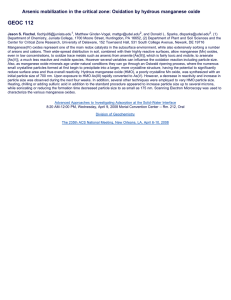Optimized procedure for sol–gel production of La Ca MnO thin films
advertisement

J Sol-Gel Sci Technol DOI 10.1007/s10971-015-3785-2 ORIGINAL PAPER Optimized procedure for sol–gel production of La2/3Ca1/3MnO3 thin films Keller Andrews1 • Anthony B. Kaye1 Received: 1 June 2015 / Accepted: 25 June 2015 ! Springer Science+Business Media New York 2015 ! Abstract Lanthanum calcium manganese oxide Lað1"xÞ Cax MnO3 Þ has a number of potentially useful magnetic and electrical properties that can be adjusted based upon its calcium fraction, x. This material has been fabricated in a number of ways, but as we approach a point at which it can be used in complex commercial applications, it is critical that we consider the cost of generating thin films in complex geometries. Therefore, we present an optimized sol–gel synthesis and thin-film generation procedure that results in repeatable, high-quality thin films of a specified thickness. Graphical Abstract Keller Andrews and Anthony B. Kaye have contributed equally to this work. & Keller Andrews keller.andrews@ttu.edu Anthony B. Kaye anthony.kaye@ttu.edu 1 Department of Physics and the Nano Tech Center, Texas Tech University, Lubbock, Texas 79409, USA Keywords Magnetic oxides $ Sol–gel processing $ Thinfilm structure and morphology 1 Introduction A number of materials with a perovskite crystalline structure exhibit solid–solid phase transitions that also have interesting and potentially useful magnetic properties [1]. The perovskites lanthanum manganese oxide ðLaMnO3 Þ and calcium manganese oxide ðCaMnO3 Þ have each been studied for their individual magnetic properties for more than 60 years [2]. When the two are combined, however, they form a modified perovskite structure that takes advantage of the ‘‘flexibility’’ of manganese that exists in both trivalent and tetravalent forms. By doping one manganese oxide with the other, we observe an enhancement of some of the previously observed magnetic effects. As one example, by heavily doping LaMnO3 with divalent calcium atoms, the resulting material has significantly enhanced colossal magnetoresistance (up to 127,000 % [3]), far beyond that of undoped LaMnO3 [4]. Because of these enhanced effects, the doped compound, lanthanum calcium manganese oxide (La1"x Cax MnO3 ; hereafter, LCMO), has become more widely studied than either of its constituents (see, e.g., [5] and references therein). Although the fraction of possible Ca doping ranges from x ¼ 0 (pure LaMnO3 ) to x ¼ 1 (pure CaMnO3 ), our principal interest in LCMO is the phase transition between the ferromagnetic metallic state to the paramagnetic insulating state, which occurs at calcium dopant levels (x) in the range 0:2\x\0:4 (see, e.g., [6] and [7]). In order to take advantage of the highest insulator-to-metal transition temperature ðTIMT Þ possible for the ultrafast solid–solid phase transition, the most common single calcium dopant 123







